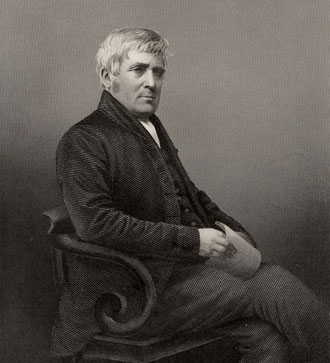
Introduction: The Origins of Antislavery in Birmingham
Transatlantic Slavery: A Historical Context
Aims for Learning
Introduction: The Origins
of Antislavery in Birmingham
This is an engraving of Joseph Sturge (1793-1859), an important
figure in the history of Birmingham, who dedicated his life to bringing
about an end to transatlantic slavery in the nineteenth century.
Sturge started out in business as a ‘corn merchant’,
but was to spend much of his life pressing for urgent social change.
A devoutly religious Quaker, an educational reformer and advocate
of working class rights, Sturge contributed to many areas of Birmingham’s
public life. His most impassioned cause remained the abolition of
slavery around the world.
Responsible for oppressing millions of Africans for an unjust
profit, the transatlantic slave trade prospered in the late eighteenth
century. Birmingham itself, a town at the centre of the industrial
revolution, was far from untainted by this trade. Selling guns,
engines, metals and a range of industrial products, its growth became
linked to profits often made indirectly from the buying and selling
of slaves. For example, we know that a proslavery petition was sent
from Birmingham to Parliament in 1789 by those manufacturers who
feared that the economy of the area would collapse without the 'African
Trade'.
This situation did not go unchallenged. Through the dedicated efforts
of a wide range of people, Birmingham also became an important centre
of antislavery activity. The origins of its antislavery campaigning
can first be traced back to the 18th century, when the industrialists,
manufacturers, inventors and intellectuals of what became known
as the ‘Lunar
Society’ (which included members such as Matthew Boulton,
James Watt, Joseph Priestly, Erasmus Darwin and Josiah Wedgwood)
first regularly debated the problem. However, it was not until around
1825 that specific antislavery organisations were started in Birmingham.
Archives from this period help to us to remember and explore the
nature of campaigns by local men like Sturge, as well as the women
who established their own powerful antislavery society. In this
fight to establish a sense of social justice in the town, Birmingham’s
resistance to slavery went beyond being the product of one man,
one organisation, or one outlook. Many black abolitionists also
visited the town to deliver lectures. In this way, campaigning against
slavery drew in a shifting mosaic of people and tactics, leaving
a strong mark on the town’s history that should not be forgot.
"Joseph
Sturge Birmingham History Trail"
"Exhibition
on Birmingham's Industrial link to the Slave Trade"
<return to top>
Transatlantic Slavery: A Historical
Context
Slaves were men, women and children wrongly stolen by European
traders from family and society and transported from Africa and
other continents as cargo on terrifying journeys (the ‘middle
passage’) across the Atlantic. It was an ordeal which huge
numbers did not survive. Those who did were destined for the Americas
or West Indies where they would spend the rest of their lives as
domestic servants or plantation labourers. As the ‘property’
of their owners, they were allowed no legal rights or cultural identity.
Many slaves rebelled at the harsh conditions, led rebellions, formed
secret gatherings and subverted their master’s authority.
From as early as 1500 until as late as 1880s, a transatlantic slave
trade continued to exert itself as an unprecedented form of global
oppression. In Britain, the first ‘Society for the Abolition
of the Slave Trade’ was formed by William Wilberforce in 1787.
By the nineteenth century, many other antislavery societies had
spread across the country, very often meeting with strong resistance
from those who believed slavery was still necessary for trade. As
a consequence, antislavery laws were only gradually introduced over
a long period of time as a result of prolonged resistance.
A landmark was reached in 1807 when the first ‘Abolition
of the Slave Trade Act’ was passed. After this time, the actual
sale of slaves in the British Colonies was illegal. However, the
use of existing slaves would still be allowed until 1834, when another
act came into effect which ended the legal right to own slaves.
Even then, a corrupt ‘apprenticeship’ system was still
enforced in the West Indies until a further emancipation date of
August 1st, 1838. Meanwhile, slavery in America continued until
President Lincoln signed the Emancipation Proclamation in 1863.
Slavery in Cuba was legal until as late as 1886.
It is also important to remember that during the history of these
long and bloody struggles, it was not only Africans who were affected.
As slavery became legally abolished, unjust forms of cheap manual
labour became widespread. Wage slavery drastically affected the
Asian continent and displaced many communities. As 2007 marks the
bicentenary of the 1807 act, it is important to remember that since
then, many forms of illegal slavery have continued to operate around
the world. We still face the challenge of resisting the legacy of
racism, poverty and oppression deeply rooted in the history of the
slave trade. The work of the nineteenth century activists is unfinished.
<return to top>
Aims for Learning
This guide to antislavery in Birmingham has several interconnected aims: (1) to show images and arguments that act as creative starting points in provoking your own personal ideas and research into a subject often surrounded by silence. (2) to illustrate how local archives can help you navigate an ongoing journey between the present and the past. (3) to open a discussion on how early antislavery activists might be linked to later human rights activities within Birmingham. (4) to suggest directions for further study.
<return to top>
Image Reference: Local Studies and History: Birmingham
Portraits Collection.
Author: Dr Andrew Green
|